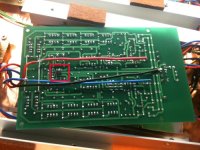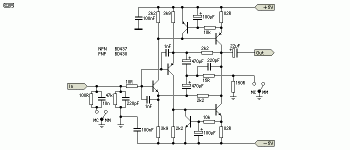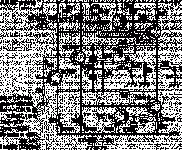Interesting point... loading this regulator with large capacitors causes a phase shift at higher frequencies, hence oscillation.... Did you try and put resistors in series with the cap (to increase ESR)? It's counter-intuitive but works well. Audio Research used a similar trick, albeit for other reasons, in their tube line stage power supply (forgot the model, I think it was the LS25).
In my phono stage the 1.5uF at the output is all I use! It feels strange to NOT have big caps there, and when I unplug it goes off immediately..... never had that before.... but the listening results and also the measurements indicate otherwise.
No worries, the SSHV, 1.2, 1.1 BIB, work with a plastic cap and small added loss from a resistor (Zobel termination) for multitudes of builds by people. Its faster that way.
Yes, i used resistors at the output. In the meantime i got quite good to making my own PSU´s so there was no big motivation to look into this more carefully.
Did you put resistance in series with the local termination elcaps or in series with the rails? The latter is wrong. Nice quality PCB that FPS, who did the layout, Jan D.? Nice results JG.
I put the resistors in series with the rails so that is wrong. I still have the circuit and i could try the modification if i find the time.
Ward Maas of Pilgham Audio did the Layout ( he calls it Elektronen Autobahn ), Sigurd Ruschkowki did the SIM. The stage was described in detail in Jan Diddens Linear 0. Yes, i am pretty happy with the result.
I still stand 100% behind the design. I do really not know how to improve it. Where we had trouble first was to zero the DC offset after the second differential stage. It has to be held constant in the plus and minus line and also between them. I solved the problem. Now we have 8 servos at work total.
Ward Maas of Pilgham Audio did the Layout ( he calls it Elektronen Autobahn ), Sigurd Ruschkowki did the SIM. The stage was described in detail in Jan Diddens Linear 0. Yes, i am pretty happy with the result.
I still stand 100% behind the design. I do really not know how to improve it. Where we had trouble first was to zero the DC offset after the second differential stage. It has to be held constant in the plus and minus line and also between them. I solved the problem. Now we have 8 servos at work total.
Here is closeup of the PCB. The differential chip is mounted on the underside in SMD.
The picture does not upload. I try later again.
That one?
Attachments
Use LEDS instead of Norton Vref if better drift is desired, but it can be inconsequential. You skipped capacitor filtering the Voltage reference resistor and trimmer on purpose? That could be an important aspect. Your build works well for Zo in its simple form, congrats.
Hi Salas,
the reference voltage really is the voltage across R4+R5, and Q4 compares this to the output voltage just like in your reg. But when the VBE of Q4 varies, so does the output voltage, and since it is not corrected by feedback the impact is large.
Yes, no cap on the reference since it is fed from a supposedly quiet voltage, the JFET isolates further, and the "regulating" action of the JFET would just be slowed down if a cap were present at that node. I think it would be better to put a lowpass filter before the base of Q4, but then I would have to deal with the base current. (I think John curl went to great lengths explaining the use of JFET current sources and resistors as reference voltage sources in the Blowtorch 1 thread somewhere).
Thank you for the flowers! I would not have ventured there if it weren't for your designs over in "your" thread, very interesting what can be concluded from such a simple arrangement.
That one?
That is the OPA1632, the differential amplifier at the output. Great little chip, only I put it the wrong way first. No explosion but a lot of current! ;-( Gladly, Farnell delivered them quickly.....
29mA is even better but sometimes the Idss of the Fets can be on the low side. This value tells me that the J-Fets are no fakes. Some of the fakes have very high values of Idss. Ward Maas has a good and reliable source though.
Post 2467, yes, that is the differential OP.
Again i try to upload the picture of the PCB.
Post 2467, yes, that is the differential OP.
Again i try to upload the picture of the PCB.
Hi Salas,
the reference voltage really is the voltage across R4+R5, and Q4 compares this to the output voltage just like in your reg. But when the VBE of Q4 varies, so does the output voltage, and since it is not corrected by feedback the impact is large.
Yes, no cap on the reference since it is fed from a supposedly quiet voltage, the JFET isolates further, and the "regulating" action of the JFET would just be slowed down if a cap were present at that node. I think it would be better to put a lowpass filter before the base of Q4, but then I would have to deal with the base current. (I think John curl went to great lengths explaining the use of JFET current sources and resistors as reference voltage sources in the Blowtorch 1 thread somewhere).
Thank you for the flowers! I would not have ventured there if it weren't for your designs over in "your" thread, very interesting what can be concluded from such a simple arrangement.
LEDS or LM329 string would not vary as much as a direct I to V converter as the Norton resistive ''Zener'' does. The drift with the Norton is due to either the TC point of the JFET (what type you use?), or the Vbe bracket's stability it nests in as you mentioned, or both. Given that a small drift can be inconsequential to some application, the Norton is cheap, easy, quiet. Surely there is good PSRR in the JG circuit, because no filtering over R4+R5 certainly is noisier than filtered, showing on the reg's final output. Anything noise source there gets amplified by the error amp BJT. An RC filter makes it higher impedance, and impacts the base current, hence OLG, PM, Zo, on the other hand. This is a custom build non the less, and since you found the application's noise floor total to spec, there is no need to slow it down.
Listening to some serious music yesterday, I wanted to mention the surprising bass quality of this phono stage that simply wasnt there before:
Massive Attack, brutal and very deep bass, overlaid with a lot of other stuff - clear and well-defined as well as brutal, no intermodulation as far as I could tell
Alan Parsons Project - deep and very clear studio bass, apparently quite a bunch of different bass guitars and sounds has been used and it all came out very clear
Supertramp - horrible card-board like bass, thin and anaemic
Kate Bush (Aerial) - electrified string bass played by Eberhard Weber, all the beautiful sound colours and his sophisticated techniques and melodies were a joy to listen too
you can tell from the above that I am a child of the eighties, and enjoying myself ;-)
Massive Attack, brutal and very deep bass, overlaid with a lot of other stuff - clear and well-defined as well as brutal, no intermodulation as far as I could tell
Alan Parsons Project - deep and very clear studio bass, apparently quite a bunch of different bass guitars and sounds has been used and it all came out very clear
Supertramp - horrible card-board like bass, thin and anaemic
Kate Bush (Aerial) - electrified string bass played by Eberhard Weber, all the beautiful sound colours and his sophisticated techniques and melodies were a joy to listen too
you can tell from the above that I am a child of the eighties, and enjoying myself ;-)
I like this music a lot too. Yes, that is what i found too. Exceptional bass and very good detailing. As i said before, the NE5534A had the best bass of all opamps i tried. Maybe it is because they are so many, maybe as a byproduct of the offset that drives them into class A, maybe it is the DC coupling all the way through, i do not know. I call what you call "brutal" "drama" or simply "PRAT factor". Power, Rhythm, Attack, Timing. What ever it is. It keeps you at the edge of the seat. I am full of joy that you got it working and that you like it.
Any time soon i am planning just for fun to build the JLH MC pre-pre. Some time ago i ordered the transistors. The reason is simple. I learned a lot by his books and articles. I must say he was one of my strongest imfluences. He never showed any extremely complex circuit i see here sometimes but what he did was beautifully clear and clean.
I ask myself the question recently how complex something must be to sound good. Sometimes complexity is the only way to get the job done. See the fully symmetric FPS.
But simplicity has it´s own charm. The other reason is that i whould like to know how far we have come in the last 20 years. His circuit is a good example what was state of the art back then . I will compare it to my recent designs and i am very curious if they sound any better.
I have a small problem with the schematics i got. I found two schematics that differ somewhat. One is DC coupled but that is not what striks me. What i find a litttle stange is that one schematic shows a supply of plus-minus 5V and the other plus-minus 1.5V or does that mean "from 1 to 5 V". Maybe anybody knows. I whould prefer the 5V anyway.
I ask myself the question recently how complex something must be to sound good. Sometimes complexity is the only way to get the job done. See the fully symmetric FPS.
But simplicity has it´s own charm. The other reason is that i whould like to know how far we have come in the last 20 years. His circuit is a good example what was state of the art back then . I will compare it to my recent designs and i am very curious if they sound any better.
I have a small problem with the schematics i got. I found two schematics that differ somewhat. One is DC coupled but that is not what striks me. What i find a litttle stange is that one schematic shows a supply of plus-minus 5V and the other plus-minus 1.5V or does that mean "from 1 to 5 V". Maybe anybody knows. I whould prefer the 5V anyway.
Attachments
I use that circuit with some mods as a headphone amp, it sounds great. I use cfp s as output transistors to lower distortion to very low levels. The best characteristic is that this design shows absence of high order distortion products at low to medium levels.
For MM/MC the results may differ though.
A copy of the original design can be seen in Ben Duncans book if you have it. I have the book but unfortunatly not a scanner.
For MM/MC the results may differ though.
A copy of the original design can be seen in Ben Duncans book if you have it. I have the book but unfortunatly not a scanner.
What i find a litttle stange is that one schematic shows a supply of plus-minus 5V and the other plus-minus 1.5V or does that mean "from 1 to 5 V". Maybe anybody knows. I whould prefer the 5V anyway.
I only know that symbol as a multiplication sign. Maybe they mean 1 times 5 volts?
Homemodder, so you use a Szikley pair at the output. I use that sometime too. Did you had any stabilty problems? Anyway, i will build the circuit as is although with other transistors at the output because i do not have that old Motorola BCs. I have the correct input trannies though.
Lauret, when i look at the idle currents, 5V is much more logical.
Lauret, when i look at the idle currents, 5V is much more logical.



